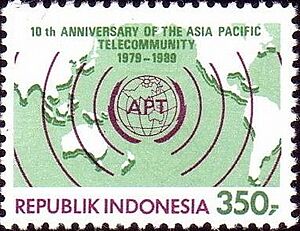Asia-Pacific Telecommunity facts for kids

Asia-Pacific Telecommunity
|
|
| Abbreviation | APT |
|---|---|
| Formation | 1 July 1979 |
| Type | International organization |
| Purpose | Telecommunications |
| Headquarters | Bangkok, Thailand |
|
Area served
|
Asia-Pacific |
|
Membership
|
|
|
Secretary General
|
Masanori Kondo |
The Asia-Pacific Telecommunity (APT) is an important group that helps countries in the Asia-Pacific region with all things related to communication. Think of it as a team that works to make sure people can connect easily through phones, the internet, and other technologies. It was started by two big organizations: the United Nations Economic and Social Commission for Asia and the Pacific (UNESCAP) and the International Telecommunication Union (ITU).
The APT was officially created by an international agreement called the Constitution of the Asia Pacific Telecommunity. This agreement was signed in Bangkok, Thailand, on March 27, 1976, and became active on February 25, 1979. The APT officially began its work on July 1, 1979. It is an intergovernmental organization, which means it's a group where different governments work together. The APT also works closely with companies that provide phone and internet services, companies that make communication equipment, and groups that research new technologies.
The APT is the main organization for Information and Communications Technology (ICT) in the Asia-Pacific area. It includes 38 member countries, 4 associate members, and 139 affiliate members.
Over the years, the APT has helped its members get ready for big international meetings about communication. These meetings include important conferences like the World Radiocommunication Conference (WRC) and the World Telecommunication Development Conference (WTDC). The APT also helps countries in the region work together and agree on their plans and activities.
Contents
What the APT Does
The Asia-Pacific Telecommunity helps develop communication services and internet systems across the region. It plays a key role in making sure that rules and technical standards for ICT are fair and work well together.
The APT also prepares for major international conferences. These include meetings about how radio waves are used (World Radiocommunication Conferences) and how communication standards are set (World Telecommunication Standardization Assemblies). The organization also hosts special groups and discussions to solve problems related to managing radio waves, setting policies, and creating standards.
Who are the Members of APT?
The APT currently has 38 member countries, 4 associate members, and 139 affiliate members. Any country that is part of the ESCAP and is located in the Asia-Pacific region can become a member of the APT. To become an associate member, a territory or group of territories in the region that is an associate member of ESCAP can join. Associate members are shown in green in the table below. A country becomes a full member of the APT by officially agreeing to its founding treaty, the Constitution of the Asia Pacific Telecommunity.
|
|
What are APT's Goals?
The main goal of the APT is to help grow communication services and internet systems across the Asia-Pacific region. It especially focuses on helping less developed areas get better access to these technologies.
To achieve this, the APT aims to:
- Help expand communication services and internet systems. This is done to make sure people in the region get the most benefits from information and communication technology.
- Encourage countries to work together on common interests, like radio communications and developing technical standards.
- Study new developments in communication technology, policies, and rules. They do this by working with other international organizations.
- Support the sharing of technology, training for people, and the exchange of information. This helps all parts of the region develop their communication services evenly.
- Help countries in the region coordinate on big communication issues. This makes the region stronger when dealing with international matters.
How is APT Organized?
The APT has three main parts that help it function:
- The General Assembly
- The Management Committee
- The General Secretariat
The General Assembly includes the President and Vice Presidents. The Management Committee has a Chairman and Vice Chairmen. The General Secretariat is made up of the Secretary General, the Deputy Secretary General, and other staff members.
The APT is also divided into five main areas, or "sectors," each handling different aspects of the Telecommunity's work. These sectors are:
- Policy and Regulations (PRF)
- Radiocommunication (RF)
- Standardization
- Human Resource Development (HRD)
- ICT Development (APTICT)
Who Leads the APT?
The APT is led by a Secretary General. This person is chosen by the member countries at the General Assembly and serves for a three-year term.
Past Leaders of APT
 Loqman Husain T.Q.A, Leg d’Hon
Loqman Husain T.Q.A, Leg d’Hon Boonchoo Phienpanji
Boonchoo Phienpanji Chao Thongma
Chao Thongma Hiroyasu Sonoki
Hiroyasu Sonoki Jong Soon Lee
Jong Soon Lee Amarendra Narayan
Amarendra Narayan Toshiyuki Yamada
Toshiyuki Yamada Areewan Haorangsi
Areewan Haorangsi Masanori Kondo
Masanori Kondo
Other Related Organizations
- Asian-Pacific Postal Union
- African Telecommunications Union (ATU)
- Caribbean Postal Union (CPU)
- Caribbean Telecommunications Union (CTU)
- European Conference of Postal and Telecommunications Administrations (CEPT)
- Postal Union of the Americas, Spain and Portugal
- List of telecommunications regulatory bodies


